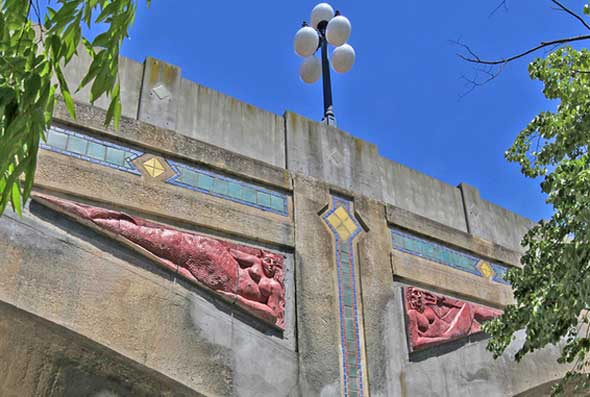A Brief History Of MTA Station Art

THE COMMUTE: Renovation of the Ocean Parkway Station is nearing completion. The MTA contracted Railworks Transit (subcontractor- Oliviera Contracting) to perform the work including structural concrete repairs, repairs to the subway platforms, platform edge removal and reinstallation including rubbing board and ADA Warning Tiles at a cost of $7.17 million (Project T50703/12).
The renovation includes 128 large reliefs in concrete depicting Coney Island’s unusual characters. The artwork created in 1996 and originally scheduled to be installed in 2010, was delayed ten years when structural defects were found in the viaduct that demanded attention.
From the MTA website:
Sculptor Deborah Masters created the Coney Island Reliefs in cast concrete. The 1260 sq. ft. of relief panels fit within existing recesses in the viaduct. Tinted a terracotta color to harmonize with the sandstone color of the Ocean Parkway viaduct, a massive structure that carries the subway across six lanes of traffic and an Olmstead parkway, the reliefs portray scenes from the history and legends of Coney Island, including Neptune, a mermaid, beach, boardwalk, and amusement park scenes.
… The work is a visual gateway into Coney Island, and a major accomplishment that met many technical challenges. The figures and images are modeled with expression, reflective of the large-scale sculpture for which the artist is known and has exhibited widely. The work seems an integral part of the historic structure and indeed, the recessed areas may have been intended for artwork that was never provided to the community, until now.
With work wrapping up at Ocean Parkway, we got to wondering why New York started using artwork in the subways. Turns out the answer was much the same then as it is now: tourism.
When the first subway was in New York built in 1904, no one knew how popular it would be or if people would even be willing to ride in a hole in the ground. Artwork was built into the subway stations to make it more attractive and encourage ridership. Forgotten-NY discusses the subways early art mosaics.
Expansion of the IRT and the BMT with the Dual Contracts paid less attention to art.
The IND, constructed in the 1930s, neglected art altogether by paying more attention to functional color-coding of the tiling of subway stations. As you leave the city center, local stations retain the same color tile as the previous express stations to serve as a reminder which express station you need to get off at to change for the local. However, most subway riders never even noticed this color-coding system.
The few subway stations that were built between the end of World War II and 1985 were extremely bland, most noteworthy the 57
thStreet and Sixth Avenue Station, featuring just white tiles with plain black lettering.
In 1985, the MTA decided to return to its roots by creating “Arts for Transit” after transit consumer groups demanded to know why other systems prominently featured artwork throughout their systems and New York did not. Arts for Transit commissioned artwork to enhance the experience for the passenger which has been growing for the past 25 years.
An index to permanent exhibits can be found on the MTA site. However if you would like to quickly see the artwork without having to ride the entire system, just go to NYCSubway.org, where virtually any question you might have about the subway system will be answered.
Sadly, local graffiti artists did not think the art was beautiful enough and already marred the bland concrete of Ocean Parkway with their own “artwork.” At least the vandals did not disturb the reliefs, yet.
The Commute is a weekly feature highlighting news and information about the city’s mass transit system and transportation infrastructure. It is written by Allan Rosen, a Manhattan Beach resident and former Director of MTA/NYC Transit Bus Planning (1981).




